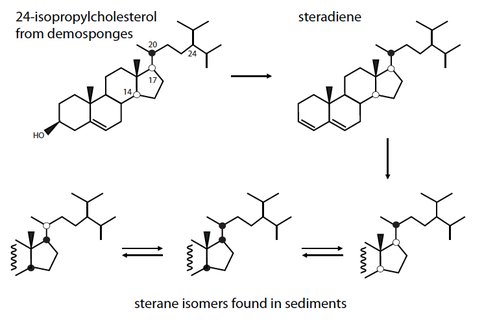2015 Annual Science Report
 Massachusetts Institute of Technology
Reporting | JAN 2015 – DEC 2015
Massachusetts Institute of Technology
Reporting | JAN 2015 – DEC 2015
Early Animals: Lipid Biosignatures
Project Summary
We established the structures of two unusual steroid-related molecules that appear to be characteristic of Neoproterozoic ecosystems.
We responded to an 2013 critique of the sponge biomarker hypothesis with a detailed rebutal. Currently, the most parsimonious interpretation of the presence of the unusual steroid, 24-isopropylcholestane, in Neoproterozoic sediments is that represents a molecular fossil of demosponges.
We devolped a new approach to evaluating the diets of early hominins based on analyese of fecal sterols. We studied the fecal sterols of great apes and determined that they were distinct from the fecal sterols of Neandethals and modern humans (Sistiaga et al., 2015).
Project Progress
We established unambiguous structures for two unusual steroid-related molecules that appear to be characteristic of Neoproterozoic ecosystems. The abundance of these sterane hydrocarbons is elevated in sediments and petroleum of Neoproterozoic-E. Cambrian age from Oman, Siberia and India. Their carbon number (C19) and structural affinity to androstane suggests the possibility that these compounds have a metazoan signaling role (Figure 1).
In a response to a prior publication, we recapitulated the evidence sterols with a rare isopropyl substituent at C-24 being the biosynthetic product of demosponges. In contrast, sterols with an n-propyl substituent at C-24 are biosynthesized by pelagophyte algae as major lipids. These sterol structures, and those of the fossil steranes that are their diagenetic counterparts, are distinct and cannot be interconverted to any significant degree during diagenesis and thermal maturation in sediment (Figure 2). Accordingly, the most parsimonious explanation for the extraordinary Neoproterozoic occurrence of high absolute and relative abundances of 24-ipc steranes, originating between 635 and 713 Ma, is that they represent chemical fossils of demosponges or their ancestors.
The conscious and deliberate sharing of food is a characteristic that distinguishes humans from all other animals. We investigated a new approach to evaluating the diets of early hominins, and their supposed reliability on meat, based on analysis of fecal sterols. In further developing this idea we studied the fecal sterols of great apes and determined that they were distinct from the fecal sterols of Neanderthals and modern humans (Sistiaga et al., 2015). While the primary aim of the study was to confirm the usefulness of our approach to the study of early hominin diet, the opportunity was also taken to record new data about the metabolism of fats and cholesterol in our closest relatives. We observed that chimpanzees and gorillas had an enhanced cholesterol metabolism that can be associated with their unusual sensitivity to cholesterol and consequent hypercholesterolemia. This sensitivity if shared in a common ancestor would involve a higher risk of cardiovascular disease for the first hominin meat eaters (Sistiaga et al., 2015).
Publications
-
Bender, M., Schmidtmann, M., Summons, R. E., Rullkötter, J., & Christoffers, J. (2015). A Geomimetic Approach to the Formation and Identification of Fossil Sterane Biomarkers in Crude Oil: 18- nor – D – homo -Androstane and 5α,14β-Androstane. Chem. Eur. J., 21(35), 12501–12508. doi:10.1002/chem.201502148
-
Love, G. D., & Summons, R. E. (2015). The molecular record of Cryogenian sponges – a response to Antcliffe (2013). Palaeontology, 58(6), 1131–1136. doi:10.1111/pala.12196
-
Sistiaga, A., Wrangham, R., Rothman, J. M., & Summons, R. E. (2015). New Insights into the Evolution of the Human Diet from Faecal Biomarker Analysis in Wild Chimpanzee and Gorilla Faeces. PLoS ONE, 10(6), e0128931. doi:10.1371/journal.pone.0128931
-
PROJECT INVESTIGATORS:
-
PROJECT MEMBERS:
Ainara Sistiaga Gutiérrez
Co-Investigator
Matthias Bender
Collaborator
Jens Christoffers
Collaborator
Gordon Love
Collaborator
Jürgen Rullkötter
Collaborator
Richard Wrangham
Collaborator
-
RELATED OBJECTIVES:
Objective 3.2
Origins and evolution of functional biomolecules
Objective 4.2
Production of complex life.


